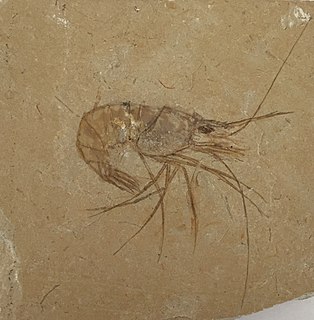
The Caridea, commonly known as caridean shrimp or true shrimp, are an infraorder of shrimp within the order Decapoda. This infraorder contain all species of true shrimp. They are found widely around the world in both fresh and salt water. Many other animals with similar names – such as ghost shrimps, mud shrimps, and boxer shrimps – are not true shrimps, but many have evolved features similar to true shrimps.

The Achelata is an infra-order of the decapod crustaceans, holding the spiny lobsters, slipper lobsters and their fossil relatives.

The Stenopodidea or boxer shrimps are a small group of decapod crustaceans. Often confused with shrimp or prawns, they are neither, but belong in a group closer to the reptant decapods, such as lobsters and crabs. They can be easily recognized by their third pereiopod, which is greatly enlarged, while for lobsters and crabs, it is the first pereiopod that is much bigger than the others. There are 71 extant species currently recognized, divided into 12 genera. Three fossil species are also recognized, each belonging to a separate genus. The earliest fossil assigned to the Stenopodidea is Devonostenopus pennsylvaniensis from the Devonian. Until D. pennsylvaniensis was discovered, the oldest known member of the group was Jilinicaris chinensis from the Late Cretaceous.

Eucarida is a superorder of the Malacostraca, a class of the crustacean subphylum, comprising the decapods, krill, Amphionides and Angustidontida. They are characterised by having the carapace fused to all thoracic segments, and by the possession of stalked eyes.

Aeger is a genus of fossil prawns. They first occur in the Middle Triassic, and died out at the end of the Late Cretaceous. A total of 20 species are known.

Luciferidae is a family of prawns. These prawns are small, characterised by bioluminescence and the loss or reduction of some appendages. They are predators of tiny planktonic crustaceans for which their third pereiopod is adapted to capture by having thick, curved spines covering the limb. Until recently, the family was thought to be monotypic, but a 2016 cladistic analysis recognized a second genus apart from Lucifer, named Belzebub.

Cancroidea is a superfamily of crabs, comprising the families Atelecyclidae and Cancridae. Four other families have been separated into new superfamilies: Cheiragonidae into Cheiragonoidea, Corystidae into Corystoidea, and both Pirimelidae and Thiidae into Portunoidea.

Palaemonidae is a family of shrimp in the order Decapoda. Many species are carnivores that eat small invertebrates, and can be found in any aquatic habitat except the deep sea. One significant genus is Macrobrachium, which contains commercially fished species. Others inhabit coral reefs, where they associate with certain invertebrates such as sponges, cnidarians, mollusks and echinoderms as cleaner shrimps, parasites, or commensals. They generally feed on detritus, though some are carnivores and hunt tiny animals.
Sergestoidea is a superfamily of prawns, divided into two families – the Luciferidae and the Sergestidae.

Hippoidea is a superfamily of decapod crustaceans known as sand crabs, mole crabs, sand bugs, or sand fleas.

Albuneidae is a little-known family of specialized burrowing sand crabs. There are 50 extant species as well as nine fossil species that have been described. Fossil specimens have been described from the Cretaceous, Miocene and Oligocene.

Cheiragonidae is a small family of crabs, sometimes called helmet crabs, placed in its own superfamily, Cheriagonoidea. It comprises three extant species, Erimacrus isenbeckii, Telmessus acutidens and Telmessus cheiragonus, there are no yet evidences of Cheiragonidae in the fossil record. Many of these crabs were formerly treated as members of the Atelecyclidae.

Farfantepenaeus is a genus of prawns in the family Penaeidae. Its eight species were formerly included in the genus Penaeus. It was first published as a genus name in 1972 by Rudolf N. Burukovsky, but without the necessary designation of a type species. That situation was corrected by the same author in 1997. The name Farfantepenaeus commemorates the Cuban carcinologist Isabel Pérez Farfante.

Carpopenaeus is an extinct genus of prawn, which existed during the Upper Jurassic and Cretaceous periods. It contains three species.
Longitergite is an extinct genus of prawn which existed in Russia during the Lower Miocene period. It contains a single species.
Paleomattea is an extinct genus of prawn, containing the single species Paleomattea deliciosa. The species is only known from the stomach contents of the fish Rhacolepis, which is referred to by the specific epithet deliciosa ("delicious"), and in the generic name, where mattea means "delicacy".
Acanthinopus gibbosus is an extinct species of shrimp placed in its own genus, Acanthinopus, which has not been assigned to a family. It was found in Norian sediments of the Zorzino Limestone in northern Italy.

Crustaceans may pass through a number of larval and immature stages between hatching from their eggs and reaching their adult form. Each of the stages is separated by a moult, in which the hard exoskeleton is shed to allow the animal to grow. The larvae of crustaceans often bear little resemblance to the adult, and there are still cases where it is not known what larvae will grow into what adults. This is especially true of crustaceans which live as benthic adults, more-so than where the larvae are planktonic, and thereby easily caught.

Alope is a genus of shrimp in the family Hippolytidae, comprising two species:

Belzebub hanseni, the ghost shrimp or ghost prawn, is a small planktonic and benthic species of prawn from the family Luciferidae.















